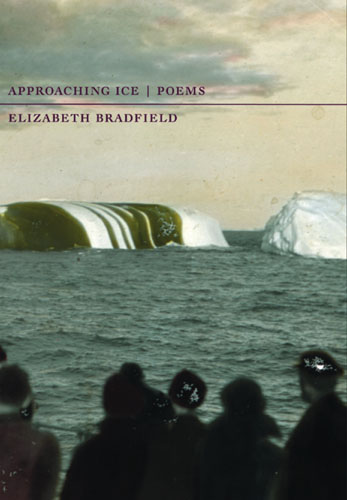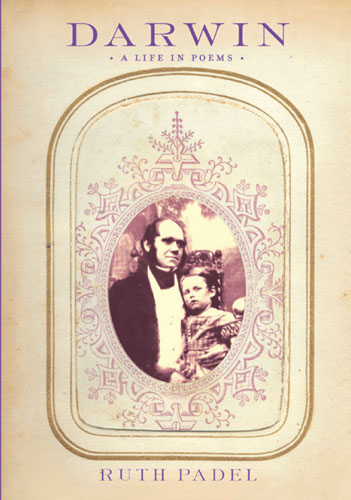
This Article From Issue
May-June 2012
Volume 100, Number 3
Page 262
DOI: 10.1511/2012.96.262
APPROACHING ICE: Poems. Elizabeth Bradfield. viii + 102 pp. Persea Books, 2010. $15 paper.
DARWIN: A Life in Poems. Ruth Padel. xviii + 141 pp. Knopf, 2009. $26 cloth, $17 paper.
If you are a scientifically trained poetry lover who has always wanted to travel to the polar regions or the tropics, or a lover of poetry who would like to venture into the history of science, you can fly away to those distant reaches on the pages of these two books. Elizabeth Bradfield, author of the poetry collection Approaching Ice, has worked as a naturalist in Alaska and the Eastern Canadian Arctic. Ruth Padel, author of Darwin: A Life in Poems, has visited tiger forests in China and Russia, as well as tropical and subtropical forests in Brazil, India, Nepal, Bhutan, Laos and Sumatra. She is, moreover, the granddaughter of Darwin’s granddaughter Nora Barlow, from whom she first heard about the complexities of the marriage of Charles and Emma Darwin.

Bradfield’s Approaching Ice is a miscellany of poems and annotated texts that makes use of the writings of two dozen Arctic and Antarctic explorers. The book unfolds in roughly chronological order, from John Cleves Symmes and James Weddell, who went north around 1820, through Roald Amundsen, Ernest Shackleton and Richard E. Byrd in the early 20th century, to Lynne Cox, who, in the late 20th century, swam the Strait of Magellan and the Cape of Good Hope.
Scattered throughout are definitions of ice formations from Nathaniel Bowditch’s The American Practical Navigator, poetically elaborated with the subtext of what seems like a love story. That story’s precise nature is never clear, although the reader senses that polar exploration is hard on domestic life. Take this example, from the last of these prose poems, whose sections each begin with one of Bowditch’s definitions:
ice-worn. Abraded by ice.
You may feel this one acutely, here at the end of this glossary.
Me? I’m polished, not worn, glossy after the passage of tons
of ice across me, the stone of my heart buffed to a sheen.
Scoured. Ready for love to find a new foothold on me.
I am not sure that the double locus of poles is enough to make this book of poems coherent, but complexity rather than coherence may be the author’s aim. She presents big personalities engaged in comic, tragic and triumphant adventures, but we often have to guess at what is driving them. Robert Louis Stevenson argued persuasively that when we read a romance, it’s better not to know too much about the protagonist, for then we more easily insert ourselves in the story and live it out. Bradfield does seem interested in the psychological oddities that drive her characters north or south, but there are so many of them that we meet them in sketchy vignettes rather than stories. So although she observes, “romance lies thicker than permafrost here,” the book hovers between romance and history.
One of the most affecting glimpses is that of “Polar Explorer Frank Hurley, Photographer on Shackleton’s Endurance Expedition (1915).” Forced by shipwreck to reduce the record of the voyage to a few pounds, as Shackleton saved his gold watch, lighter and coins, Hurley laid his glass negatives on the ice and inspected each one:
they declared
what mattered most: silver nitrate
lyrics, spoken light.
He made shards
of some 400 plates then packed a few reels of motion
film, prints already made, and the 120 negatives left unbroken.
Hurley guarded these treasures for half a year on the ice shelf and then for several months more on Elephant Island, waiting for rescue. And here is an account of Apsley Cherry-Garrard in 1911 trying to bring back penguin eggs for scientific study, although due to myopia he kept tripping and dropping them:
Carrying the thin shells back,
tent shredded by wind, boots lost to wind,
stove fueled with the emperors’ flensed meat.
Direction blown asunder and the mind’s progress in question.
At the ends of the Earth, the poet suggests, the few bits we can amass reveal their infinite value, their true meaning.

Approaching Ice engages with the history of science by focusing on the human quest to reach and explore the poles, then refracting and multiplying many glimpses of that quest. Readers who find themselves wishing, as I did, for fewer characters and more plot should turn to Ruth Padel’s Darwin: A Life in Poems, which follows Charles Darwin from birth to death in episodes that, like Bradfield’s book, make interesting poetic use of prose. Notes in the margins tell us whose letters or documents are being cited, and Padel manages the cadences of prose quite skillfully. Sometimes the marginal notes add important historical detail. Although Darwin was a rather sickly man of science, his life was enlivened by the famous voyages, his wife and children, and a long-distance collaboration with Alfred Russel Wallace.
Here is Darwin’s reaction (his own words fitted into lines of verse) to his initial encounter with rainforest in 1832: “Delight / is too weak a word for how a naturalist, / alone the first time with all this, must feel.” Padel’s embroidery on the silk of prose is surely the record of someone who also once stood in Brazilian rainforest:
He’s walking into every dream he’s ever seen:
tasselled seedpods, trefoil, nodule;
shrapnel of decaying trees like giant
columns of a fallen temple, their gold-bone
mossy architraves upwelted with lianas.
Creepers—and a strangler ficus—crafting their way
to the light. Relationships! . . .
The luxuriance of language here seems like syntactical onomatopoeia. The sections that record the end of Darwin’s voyage, his visits to Patagonia and the Galápagos Islands, use the same exuberant language, weaving taxonomy and precise botanical and zoological description into poetry.
Darwin, who was reclusive and homely, was lucky to find a devoted wife in his cousin Emma Wedgwood. The one issue that divided them was religion, since Darwin’s studies and his conception of truth as empirical led him early on to abandon Christianity. But here they are, betrothed:
They stood
silent in the drawing-room, surprised.
She’d be engineer of all his happiness. Bees
shifted honey-bags up his spine. He was roses
burning alive, and she was the haze
above tropical forest plus the unfathomed riches
within. Like giving to a blind man eyes.
That last phrase Darwin himself wrote after seeing tropical vegetation for the first time, on the Cape Verde Islands. His vision of nature was entwined with the lives of his children, too. The poem “A Sacred Feeling about Orchids” is made up almost entirely of quotations from his children who remember “the glory of being with him in the woods,” lawn, pond, study and field.
Wallace, Darwin’s admirer and acolyte, went to the Spice Islands in 1858. Padel observes, in the margin of the poem “A Birthday on the Island of Ternate,” that both thinkers were led to see the connection between variation and selection because the processes of evolution express themselves most dramatically across islands, as living forms leap over and later are divided by the sea. Weaving together letters and reports of the two friends, Padel shows why in its best versions, scientific collaboration produces the deepest and most lasting insights; and why, come to think of it, theory depends on studies in the field. In “Painting the Bees,” she writes,
Out
past the sandpit to the Light Side’s open view
of cloudshadow in Great Pucklands Meadow. Sun.
. . . . . . . . . . . . . . . . . . . . . . . . . . .
He strings all seven children over
long grass and scabious in a chain, to paint
and track the bumblebees who pollinate red clover.
The idyll of her grandmother Nora’s house, Padel reflects in the author’s note that begins the book, must have owed a great deal to the Darwins’ Down House in Kent.
Emily Grosholz is professor of philosophy and a member of the Center for Fundamental Theory at the Pennsylvania State University; she is also a member of REHSEIS / SPHERE at the Centre National de la Recherche Scientifique, Paris. She is working on a sixth volume of poetry as well as a sequel to her book Representation and Productive Ambiguity in Mathematics and the Sciences (Oxford University Press, 2007).
American Scientist Comments and Discussion
To discuss our articles or comment on them, please share them and tag American Scientist on social media platforms. Here are links to our profiles on Twitter, Facebook, and LinkedIn.
If we re-share your post, we will moderate comments/discussion following our comments policy.